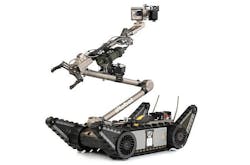Canadian military chooses iRobot UGVs to detect chemical agents, explosives, and radiation
Officials of the Canadian Department of National Defence in Ottawa have awarded multi-year contracts to iRobot initially worth $9.6 million for 20 iRobot 510 PackBot CBRN Recce UGVs with sensor suites that detect chemical, biological, radiological, and nuclear threats.
The CBRN sensors integrate five primary sensors are designed to detect, alert and report on chemical warfare agents, toxic industrial chemicals, volatile gases, explosives, and radiation. The robot also has rear flippers to enhance mobility. The contract includes training and future product lifecycle support.
The iRobot 510 PackBot CBRN Recce UGV robot is a modular expansion to the company's 510 PackBot multi-mission robot that meets Canadian military requirements. The company will deliver the ground robots by April 2015.
The base 510 PackBot multi-mission platform is able to integrate additional sensors to assist with the identification and interrogation of CBRN threats. The robot also is for missions including explosive ordnance disposal, reconnaissance, route clearance and data collection in industrial settings.
For more information contact iRobot online at www.irobot.com, or the Canadian Department of National Defence at www.forces.gc.ca.
